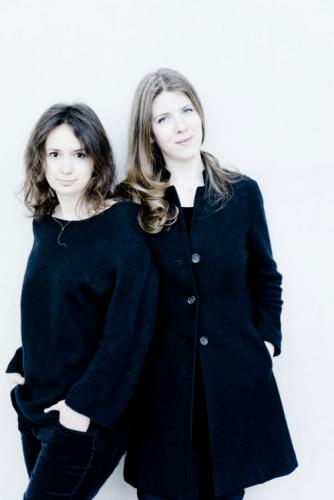An electrifying DC debut by Kopatchinskaja, Leschenko at Phillips Collection

Patricia Kopatchinskaja and Polina Leschenko performed at the Phillips Collection on Sunday. Photo: Marco Borgggreve
Patricia Kopatchinskaja makes waves wherever she goes.
The Moldovan violinist finally came to Washington on Sunday afternoon, presenting a hard-edged program at the Phillips Collection. Her inclination toward modern repertory, seen here in three thistly sonatas from the 20th century, should be more noteworthy than her tendency to play barefoot (as she did indeed do on Sunday).
There was real fire in the first movement of Poulenc’s Violin Sonata, just as the composer requested in his tempo marking. Kopatchinskaja attacked the main theme savagely, at a wildly fast tempo, although at the expense of some details. The second theme in this movement had a more lustrous sheen, but in the slow “Intermezzo” movement Kopatchinskaja sounded understated, almost blasé.
Her technique is impressively virtuosic, with the possible exception of double stops, in which intonation often did not sound quite true, as in the section in parallel sixths in the second movement. While Kopatchinskaja was again off to the races in the “Presto tragico” finale, it was really Russian pianist Polina Leschenko who earned major plaudits, not only keeping pace with her partner but pushing her comfort level with her own fierce fingerwork.
The first half of Bartók’s Violin Sonata No. 2 is essentially a lengthy recitative in folk style, which can tire in the wrong hands. Kopatchinskaja’s rubato eluded prediction, as she mooned over the introduction, a repeated note a seventh away from the pedal note in the piano. Her sound at full volume was like a buzzsaw, pointed and explosive in solo moments and vying with the often overwhelming volume of Leschenko in the second movement. When the pair accelerated the tempo, a hallmark of folk music, they almost spun out of control but pulled back from the brink in thrilling fashion.
Following the Bartók with George Enescu’s Violin Sonata No. 3, which he subtitled “In Romanian Folk Character,” might have been too much of a good thing. Kopatchinskaja’s broad, throaty tone on the G string and rapid pacing made the first movement moody and elusive. Her flautando high notes impressed at the end of the first movement, but the complex harmonics and octave double-stops in the second movement presented more pitchy intonation. Leschenko again lit the fire of this sonata’s brilliant finale, her thundering rumble in the bass part of the keyboard given epic scope.
Ravel’s Tzigane offered more folk music-inspired fireworks. Kopatchinskaja took exceptional liberties with the tempo of the piece, evoking the flair of a Roma folk fiddler. In the parts that most suited her technical strengths, especially the flawless running accuracy of her left hand, she was electrifying. With Leschenko shadowing her adroitly, she pulled and stretched the tempo of the piece with infinite variety, bringing out little details at every turn.
Mercifully the pair let up on the intensity a little for two less strenuous encores. Kopatchinskaja went full Harpo Marx in the sly strains of Georgian composer Giya Kancheli’s Rag-Gidon-Time, a jazzy foxtrot of suspended silences and coy gags, dedicated to violinist Gidon Kremer. Two movements from Alfred Schnittke’s Suite in the Old Style first brought down the temperature with the gentle “Menuett” and then raised it again in the blistering “Fugue.”


